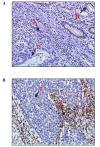Microsatellite Instability and Altered Expressions of MLH1 and MSH2 in Gastric Cancer
- PMID: 30803214
- PMCID: PMC6897031
- DOI: 10.31557/APJCP.2019.20.2.509
Microsatellite Instability and Altered Expressions of MLH1 and MSH2 in Gastric Cancer
Abstract
Introduction: Microsatellite instability (MSI) is a hallmark of defective DNA mismatch repair (MMR) of genes especially MLH1 and MSH2. It is frequently involved in the carcinogenesis of various tumours including gastric cancer (GC). However, MSI in GCs have not been reported in Malaysia before. Objective: This study was conducted to determine the microsatellite instability (MSI) status in gastric cancer by microsatellite analysis, sequencing, its association with MLH1 and MSH2 protein expression and H.pylori infection by immunohistochemistry. Method: A total of 60 gastric cancer cases were retrieved. DNA was extracted from paired normal and tumour tissues while MLH1 and MSH2 protein expression as well as H. pylori status were determined by IHC staining. For microsatellite analysis, polymerase chain reaction (PCR) was performed for paired tissue samples using a panel of five microsatellite markers. MSI-positive results were subjected for DNA sequencing to assess mutations in the MLH1 and MSH2 genes. Results: Microsatellite analysis identified ten MSI positive cases (16.7%), out of which only six cases (10.3%) showed absence of MLH1 (n=3) or MSH2 (n=3) protein expression by IHC. The most frequent microsatellite marker in MSI positive cases was BAT26 (90%). Nine of ten MSI positive cases were intestinal type with one diffuse and all were located distally. H. pylori infection was detected in 13 of 60 cases (21.7%) including in three MSI positive cases. All these results however were not statistically significant. Our sequencing data displayed novel mutations. However these data were not statistically correlated with expression levels of MLH1 and MSH2 proteins by IHC. This may be due to small sample size to detect small or moderately sized effects. Conclusion: The frequency of MSI in this study was comparable with published results. Determination of affected MMR genes by more than two antibodies may increase the sensitivity of IHC to that of MSI analysis.
Keywords: Gastric cancer; microsatellite instability; immunohistochemistry; microsatellite analysis.
Creative Commons Attribution License
Conflict of interest statement
No conflicts of interest were disclosed throughout the study.
Figures




Similar articles
-
Relationship between MLH1, PMS2, MSH2 and MSH6 gene-specific alterations and tumor mutational burden in 1057 microsatellite instability-high solid tumors.Int J Cancer. 2020 Nov 15;147(10):2948-2956. doi: 10.1002/ijc.33115. Epub 2020 Jun 18. Int J Cancer. 2020. PMID: 32449172 Free PMC article.
-
Microsatellite instability and novel mismatch repair gene mutations in northern Chinese population with hereditary non-polyposis colorectal cancer.Chin J Dig Dis. 2006;7(4):197-205. doi: 10.1111/j.1443-9573.2006.00269.x. Chin J Dig Dis. 2006. PMID: 17054581
-
Immunohistochemical Analysis of Mismatch Repair Gene Proteins in Early Gastric Cancer Based on Microsatellite Status.Digestion. 2021;102(5):691-700. doi: 10.1159/000510679. Epub 2020 Oct 14. Digestion. 2021. PMID: 33053554
-
Universal endometrial cancer tumor typing: How much has immunohistochemistry, microsatellite instability, and MLH1 methylation improved the diagnosis of Lynch syndrome across the population?Cancer. 2019 Sep 15;125(18):3172-3183. doi: 10.1002/cncr.32203. Epub 2019 May 31. Cancer. 2019. PMID: 31150123 Review.
-
Microsatellite instability: an update.Arch Toxicol. 2015 Jun;89(6):899-921. doi: 10.1007/s00204-015-1474-0. Epub 2015 Feb 22. Arch Toxicol. 2015. PMID: 25701956 Review.
Cited by
-
Clinicopathological features of tumor mutation burden, Epstein-Barr virus infection, microsatellite instability and PD-L1 status in Chinese patients with gastric cancer.Diagn Pathol. 2021 May 1;16(1):38. doi: 10.1186/s13000-021-01099-y. Diagn Pathol. 2021. PMID: 33933102 Free PMC article.
-
Microsatellite Instability: From the Implementation of the Detection to a Prognostic and Predictive Role in Cancers.Int J Mol Sci. 2022 Aug 5;23(15):8726. doi: 10.3390/ijms23158726. Int J Mol Sci. 2022. PMID: 35955855 Free PMC article. Review.
-
Transcription Factor AP4 Mediates Cell Fate Decisions: To Divide, Age, or Die.Cancers (Basel). 2021 Feb 8;13(4):676. doi: 10.3390/cancers13040676. Cancers (Basel). 2021. PMID: 33567514 Free PMC article. Review.
-
Low incidence of microsatellite instability in gastric cancers and its association with the clinicopathological characteristics: a comparative study.Sci Rep. 2023 Dec 8;13(1):21743. doi: 10.1038/s41598-023-48157-7. Sci Rep. 2023. PMID: 38065969 Free PMC article.
-
PreMSIm: An R package for predicting microsatellite instability from the expression profiling of a gene panel in cancer.Comput Struct Biotechnol J. 2020 Mar 19;18:668-675. doi: 10.1016/j.csbj.2020.03.007. eCollection 2020. Comput Struct Biotechnol J. 2020. PMID: 32257050 Free PMC article.
References
-
- Boland CR, Thibodeau SN, Hamilton SR, et al. A National Cancer Institute Workshop on Microsatellite Instability for Cancer Detection and Familial Predisposition: Development of International Criteria for the Determination stabimty in colorectal Cancer for the Determination of Microsatellite Instabi. Interpret A J Bible Theol. 1998;58:5248–57. - PubMed
-
- Brennetot C, Buhard O, Jourdan F, et al. Mononucleotide repeats BAT-26 and BAT-25 accurately detect MSI-H tumors and predict tumor content: Implications for population screening. Int J Cancer. 2005;113:446–50. - PubMed
-
- Buhard O, Cattaneo F, Yick FW, et al. Multipopulation analysis of polymorphisms in five mononucleotide repeats used to determine the microsatellite instability status of human tumors. J Clin Oncol. 2006;24:241–51. - PubMed
-
- Cai KQ, Albarracin C, Rosen D, et al. Microsatellite instability and alteration of the expression of hMLH1 and hMSH2 in ovarian clear cell carcinoma. Hum Pathol. 2004;35:552–9. - PubMed
MeSH terms
Substances
LinkOut - more resources
Full Text Sources
Medical
Miscellaneous

